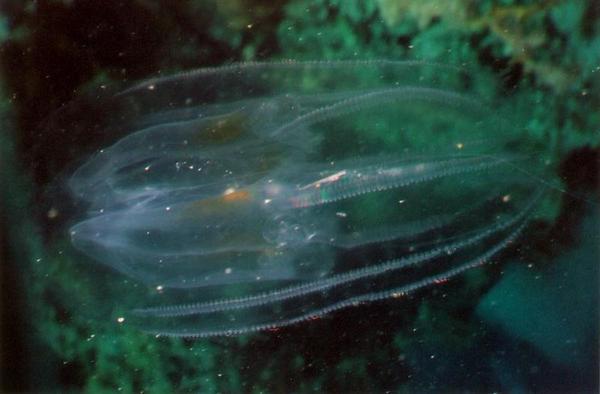DrySuitDave
Contributor
Was at Santa Rosa Island off California the other day and I was hanging on the anchor line doing a safety stop after about an hour or so at 70 feet.
The water was somewhat dirty with flotsam and jetsam streaming past me quite fast. Out of the blue I see this critter that is about 8" tall with a few vestiges of small tentacles hanging down and pretty much completely see-through. It was motionless and just flew past me. The next one to come by I looked at closely. There was essentially no tissue to it like a jellyfish might have. There were faint small organg dots over the outer surface. Inside of it, there were four verticle quadrants, the outermost edges had a vertical row of biolumnescent dots that fires in rapid vertical sequence upwards, only to restart and cycle again at about 2 per second.
I decided to intercept the next one without grabbing it, so I put my open hand in position, and the next one that streamed by, when it hit my opened gloved hand, it shredded into a zillion pieces. Poor guy, didn't know that was going to happen.
I guessed it was a siphonophore, but someone on the boat said it was a "tinaphore" if that is even the correct spelling, although phonetically correct. I coulnd't find anything on the net using that spelling. I always thought these things were very deep.
Here is a link to something similar, but what I saw was not quite as pointy on top, and it had a shorter height to diamete aspect ratio:

Ideas?
The water was somewhat dirty with flotsam and jetsam streaming past me quite fast. Out of the blue I see this critter that is about 8" tall with a few vestiges of small tentacles hanging down and pretty much completely see-through. It was motionless and just flew past me. The next one to come by I looked at closely. There was essentially no tissue to it like a jellyfish might have. There were faint small organg dots over the outer surface. Inside of it, there were four verticle quadrants, the outermost edges had a vertical row of biolumnescent dots that fires in rapid vertical sequence upwards, only to restart and cycle again at about 2 per second.
I decided to intercept the next one without grabbing it, so I put my open hand in position, and the next one that streamed by, when it hit my opened gloved hand, it shredded into a zillion pieces. Poor guy, didn't know that was going to happen.
I guessed it was a siphonophore, but someone on the boat said it was a "tinaphore" if that is even the correct spelling, although phonetically correct. I coulnd't find anything on the net using that spelling. I always thought these things were very deep.
Here is a link to something similar, but what I saw was not quite as pointy on top, and it had a shorter height to diamete aspect ratio:

Ideas?





